MOTAT celebrates 150 years of fire-fighting in Auckland

150 years of fire-fighting in Auckland
MOTAT team members have put in many hours of work to prepare several of our heritage fire-fighting vehicles to be a part of a celebration of 150 years of service in Auckland. This event has been arranged by Auckland Fire Brigade Museum and Historical Society in conjunction with Fire and Emergency New Zealand (FENZ.)
The MOTAT vehicles date from 1935 with the first Ford V8 ordered for New Zealand’s Fire Service right through to 2012 – the retirement year for Auckland’s long-serving iconic 1981 Mack Aerialscope. The range of appliances on show includes turntable ladders, pumping appliances, telescopic ladders, and a control car used by officers to attend fire emergencies.
It has been a huge team effort to get so many appliances ready for the event – full servicing of the road-worthy vehicles has been completed so they are ready to be driven to The Cloud. In conjunction with this, research has been completed on all 10 vehicles attending the event, highlighting the role each has played in responding to significant emergencies in Auckland’s history. New photography of the vehicles has also been undertaken with the support of Auckland War Memorial Museum.
The anniversary event will take place on Sunday 17 March at The Cloud on the waterfront, where MOTAT collection objects will joined by present-day emergency response vehicles, showing how technology has changed over the years. Partner agencies include NZ Police, Hato Hone St John, Auckland Emergency Management, NZ Defence Force, Red Cross and others will also be taking part.
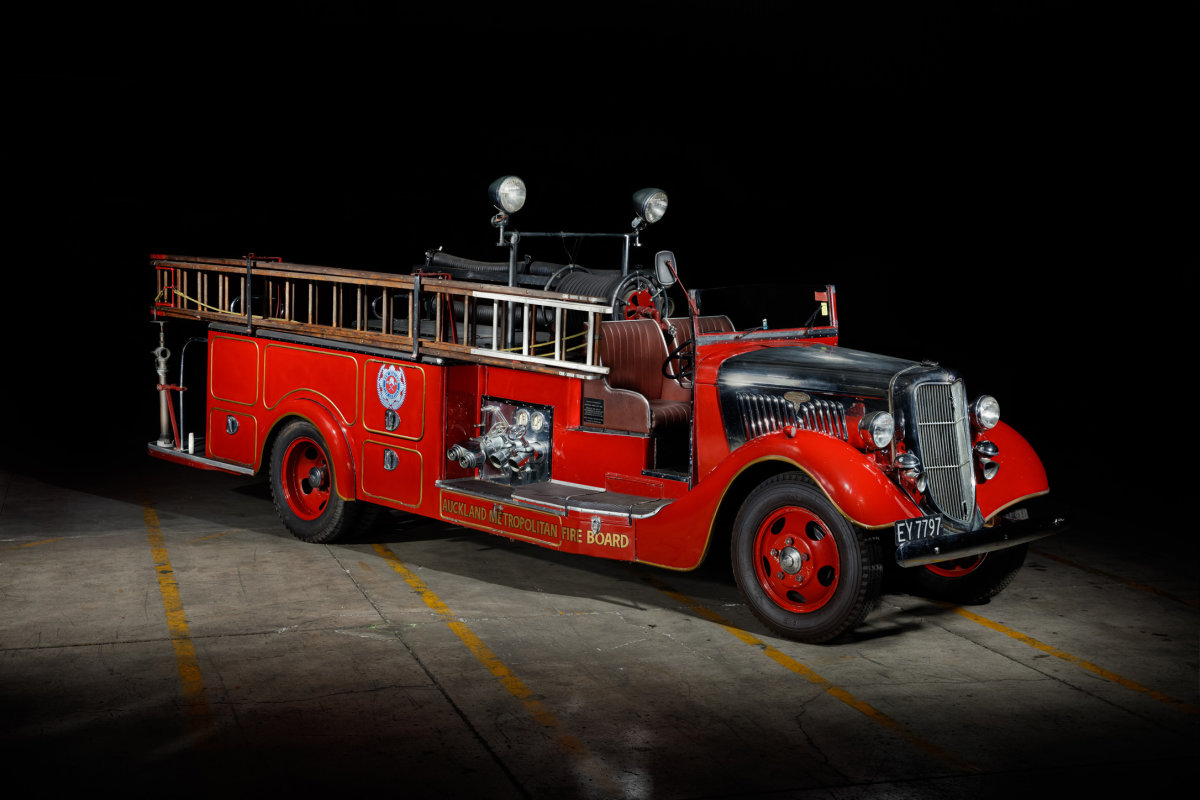
1935 Ford V8
Nicknamed ‘The Rattler’, this 1935 Ford V8 was first of this type of engine bought by the Auckland Metropolitan Fire Board, which was formed in 1933.
Along with the Ford Canada-origin chassis, the pump was assembled and modified by the Colonial Motor Company (CMC), who had established a branch for the manufacture of fire engines and firefighting equipment.
Up to 8 firefighters were now able to sit inside a well in the vehicle, facing each other. Two firefighters could also stand on the rear platform, facing forward to the engine, instead of outward as on previous machines.
This vehicle served for many years as the ‘Flyer,’ set as the first engine out of Headquarters Station. The flying squad was a feature of the service for many years and was relied upon to turn out in under 25 seconds day or night.
Image: Fire Engine, 1982.1005. The Museum of Transport and Technology (MOTAT).
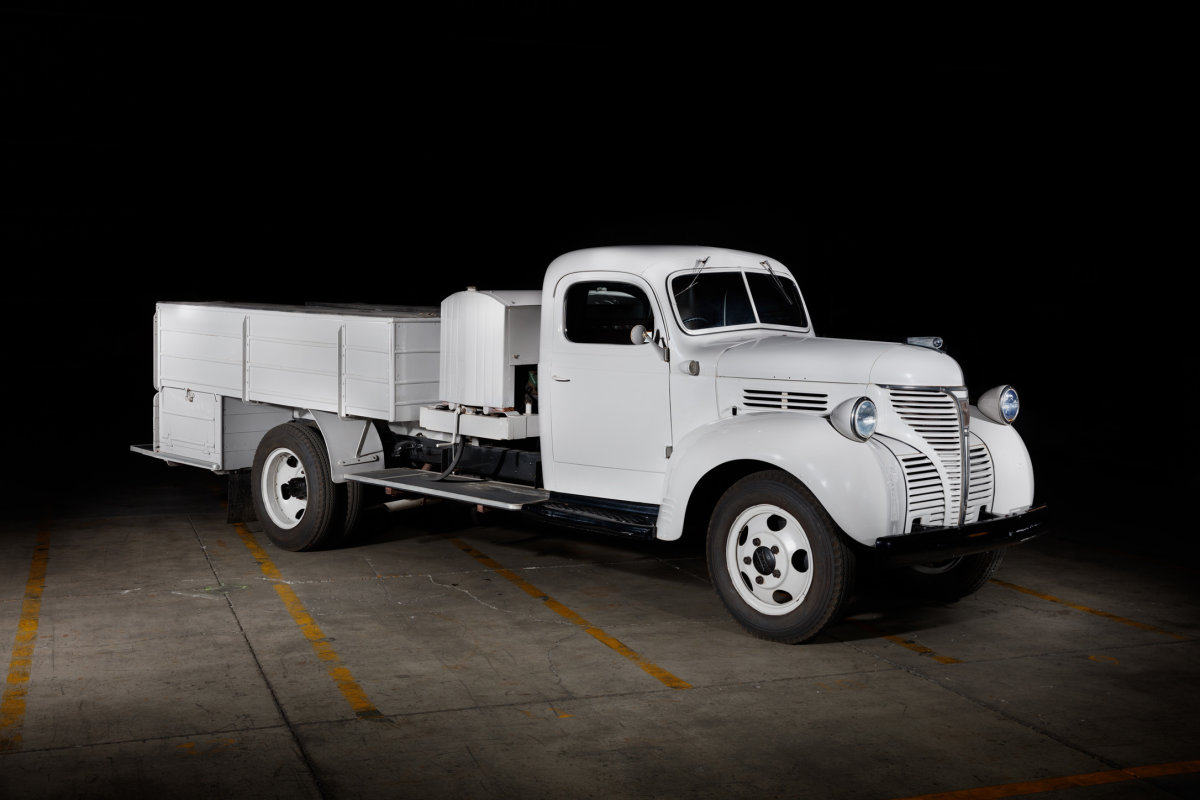
1943 Fargo combination unit
Fargo was a relatively rare badge applied to a Dodge truck as Chrysler had absorbed both the Fargo and Dodge manufacturing companies. This one was produced in 1943 to support New Zealand's Emergency Precautions Scheme (EPS). The Scheme was setup in 1935 to help the country respond to a natural disaster or enemy attacks. This was one of 17 ordered to assist with firefighting resulting from air raids during WWII.
Essentially, this has a 1940/41-style Dodge truck base, a Chrysler/Dodge ‘Job-Rated’ platform with a stronger frame than previous Dodge trucks, using higher-tensile steel. Job Rated trucks had the frame-rails extending forward from the chassis past the engine, tied together by strong bumpers as frame reinforcement.
Painted in wartime grey, this truck was bodied in Wellington by former Ford Model T assemblers Colonial Motor Company and fitted with a Colomoco (Colonial Motor Company) pump powered by a Ford V8 engine. Combination fire vehicles like this would often tow an additional trailer pump. They were deployed all over New Zealand for emergencies.
After wartime service, this Fargo was bought by the Napier fire board.
Image: Fire Engine, F1161.2003. The Museum of Transport and Technology (MOTAT).
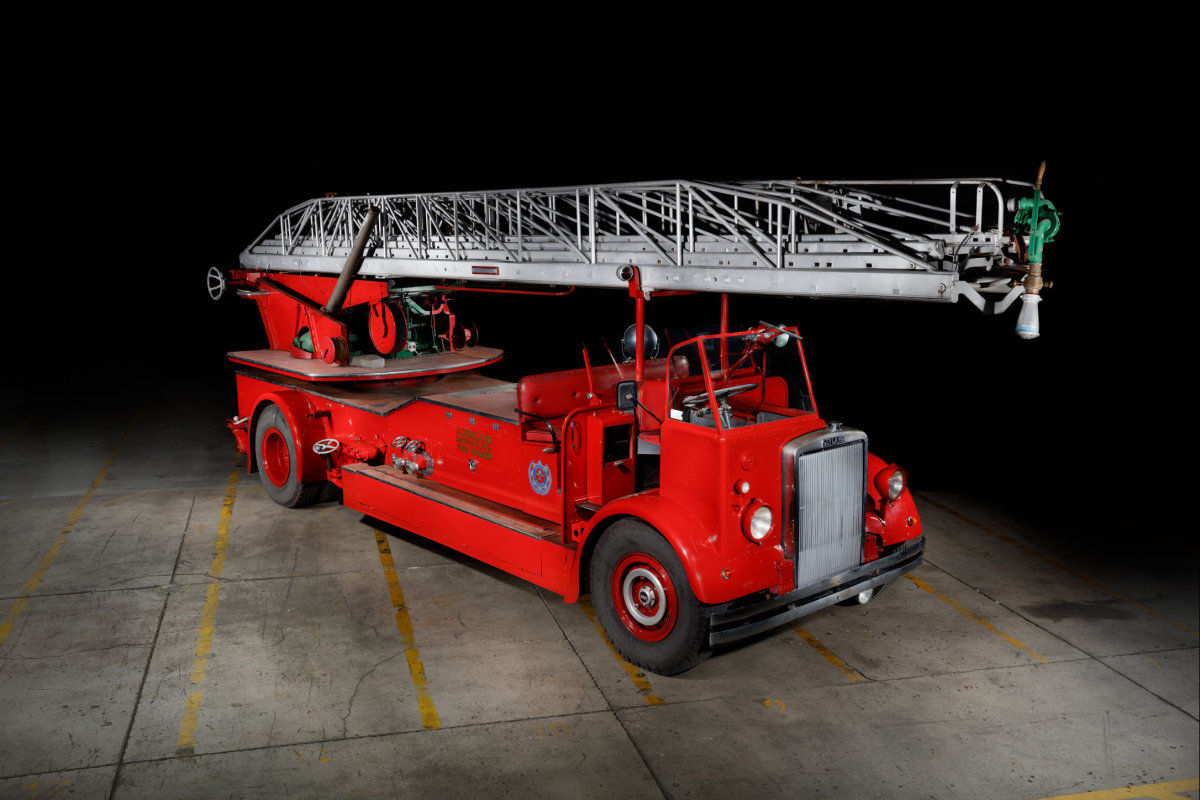
1948 Leyland Merryweather ‘Turntable Ladder’ (TTL)
English commercial vehicle manufacturer Leyland built trucks and buses, plus fire engines from 1909-1993. This 1948 TTL was used in Auckland 1948-1977, when it was moved to Christchurch, where it was operated for another two years.
It is built on 1945 Leyland OPD1A double-decker bus chassis and the turntable ladder was added by venerable fire equipment manufacturer Merryweather (established around 1690!) The ladder a 1930s design which relies on clutches and screws for elevation and extension. The vehicle body is made from mahogany timber and all the fittings were originally brass, which were later chromed.
This 1948 TTL was New Zealand’s very first diesel-fuelled fire engine, commissioned in July 1948. In service, it was quickly christened "Thunderguts" by local firefighters.
Image: Fire Engine, 1982.62.33. The Museum of Transport and Technology (MOTAT)
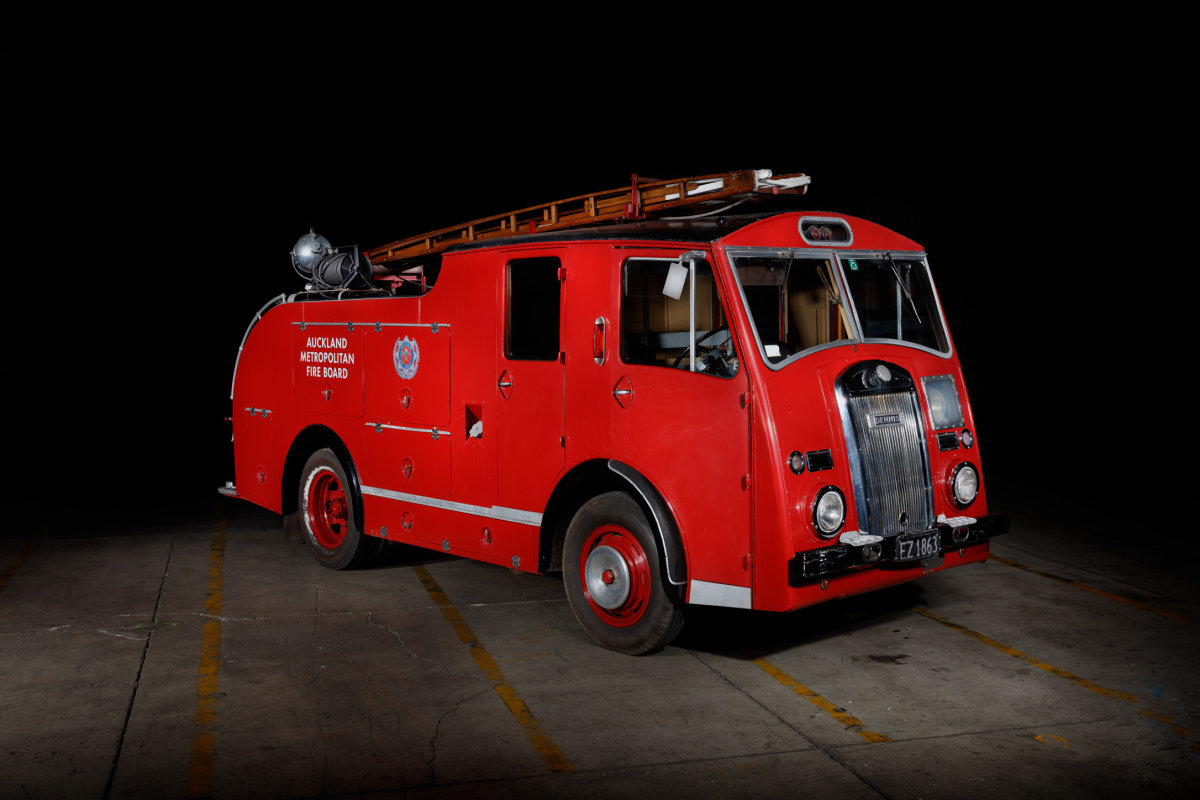
1955 Dennis F8
Between 1953 and 1955, the Auckland Metropolitan Fire Board purchased five Dennis F8 fire appliances. Powered by a Rolls-Royce B60 engine, it is the six-cylinder version of the interchangeable powerplant designed for the British military. The F8 was another stalwart of the service and another distinctively British design of fire engine.
The appliance has a large red enclosed cab, hence the ‘Limousine’ term sometimes applied, two individual front seats and a rear bench-seat. There are compartments inside the back of the truck, fire equipment on the back of the truck and braces for the 10.66 metre ladder. It is also equipped Dennis no. 2 pump which could deliver 2273 litres of water per minute and a 450-litre tank.
This F8 served Tāmaki Makaurau in Ellerslie, Mt Roskill, Onehunga, Central, Parnell and Ōtāhuhu. It was withdrawn from service and donated to MOTAT in 1982.
Image: Fire Engine, 1982.62.27. The Museum of Transport and Technology (MOTAT).
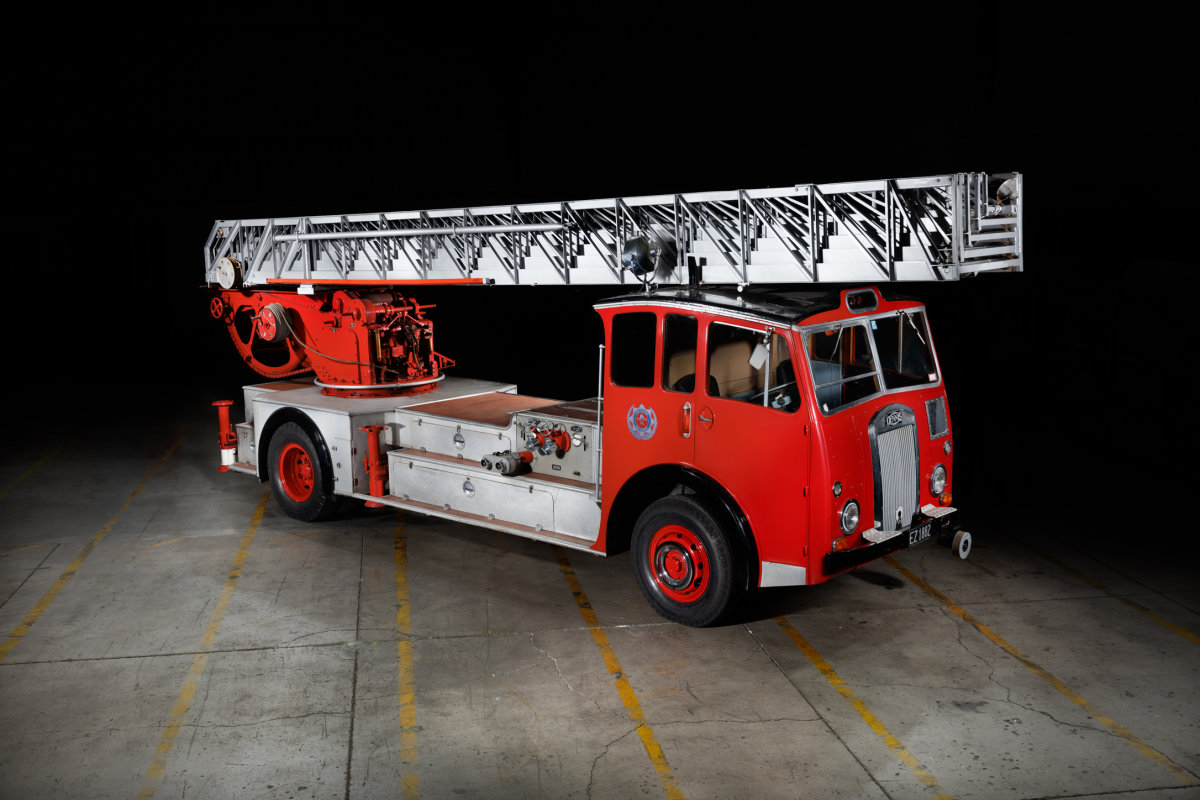
1955 Dennis Metz DL37 Table Ladder TTL
One of only six worldwide manufactured with a 38-metre telescopic ladder, this British appliance is paired with a German-manufactured Metz (founded in 1842) extending ladder on a revolving turntable to a Dennis commercial chassis. The Dennis TTL was in turn powered by a Rolls-Royce engine originally designed for heavy, military armoured cars.
Among the many fires it attended, it attended the Farmers Trading Company Bulk Store (Tāmaki Makaurau/Auckland) fire of 1963. This major fire needed 20 pumps to get it under control and led to the hospitalisation of over 30 firefighters due to smoke inhalation from burning cork.
It was in service at Auckland Central Fire Station between 1957 and 1971, before going to Parnell when replaced by the International Snorkel. It was transferred to Ōtāhuhu in 1976 and then Ōtara in in 1977 and finally decommissioned in June 1981.
Image: Fire Engine, F1157.2003. The Museum of Transport and Technology (MOTAT)
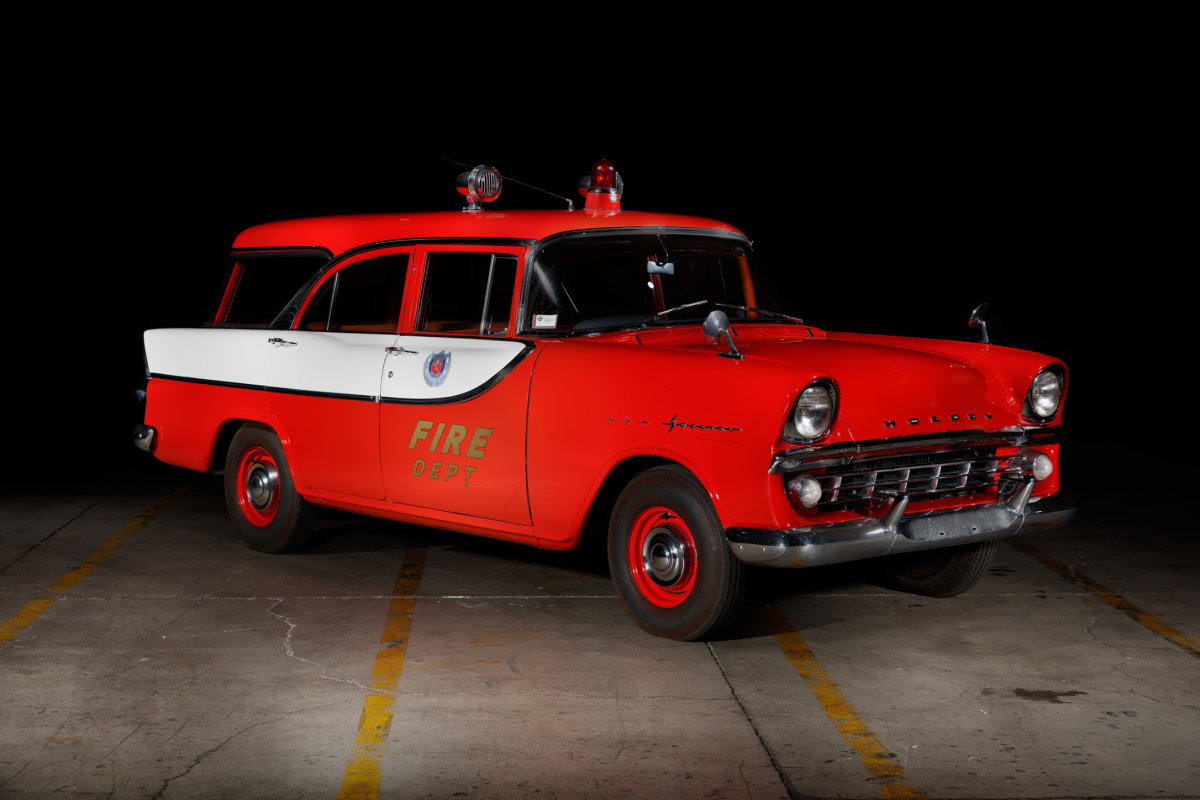
1960 Holden FB Special Station Sedan ‘fire control car’ [replica]
New Zealand’s first dedicated Fire Control Car was put into service in 1960 by Auckland’s Chief Fire Officer, Gordon Drummond, who carried out this position between 1956 – 1963. Drummond had the then-new car fitted with sirens, a red revolving light between them and a radio antenna on the roof.
The car delivered senior officers to serious fires as a mobile command centre, carrying information including maps locating water supply. It was used by Drummond’s successor, Lloyd Wilson, from 1963-1970 and attended multiple events all over Auckland. The Holden then occupied the same role for Auckland’s Southern Command between 1970-73.
In 2002, MOTAT’s Road Transport Section found an identical vehicle to recreate the iconic control car, a straight example with surface rust and a seized motor. The motor was removed and reconditioned in Auckland, while the body went to a panel beater in Hikurangi, who also painted the car and fitted the sirens and beacon.
Image: Automobile, 2004.591. The Museum of Transport and Technology (MOTAT).
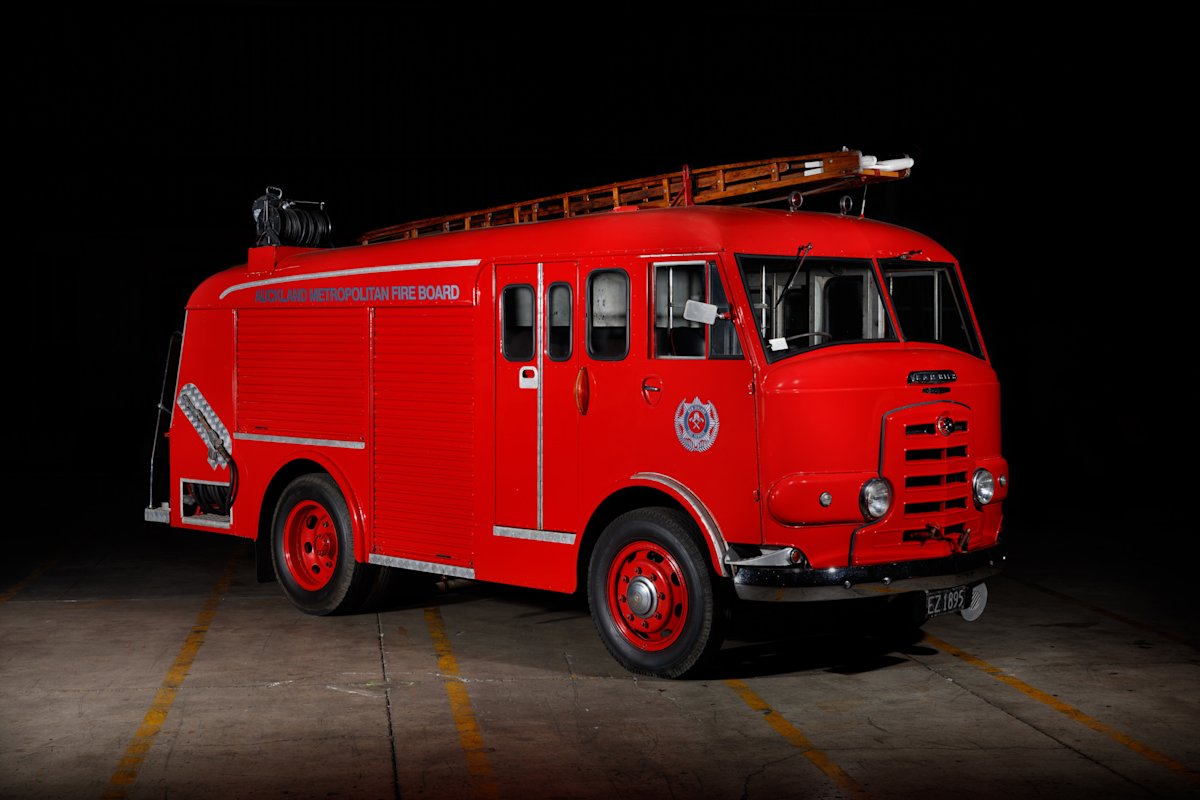
1960 Karrier
The Karrier brand came under English vehicle manufacturers Rootes Brothers in 1934 and was becoming a rare badge by the 1950s. The Gamecock model was introduced in 1950 with underfloor engine and a steel cab configuration, along with 16-inch wheels to achieve a lower loading platform. Due to their lightness (aluminium and wooden construction), they could be powered by large automobile motors – indeed, the MOTAT example has a Humber Super Snipe six-cylinder engine.
With the New Zealand fire service closely modelled on the United Kingdom example, Auckland bought 12 of these Karrier Gamecock pumps plus a Karrier Bantam hose layer. The first Karrier fire
appliances arrived in New Zealand in 1958, shipped complete from England with custom bodies by Carmichael & Sons. Appliances like this often served for over three decades.
Good performers in England’s narrow streets, their ‘fog guns’ dealt effectively with blazes in mainly brick houses. In Auckland, their efficacy was tested by Auckland’s hills and the fiercer fires of predominantly wooden houses. They were eventually replaced by sturdier trucks with more powerful engines and more comprehensive water delivery systems.
Image: Fire Engine [Karrier], 1986.47. The Museum of Transport and Technology (MOTAT).
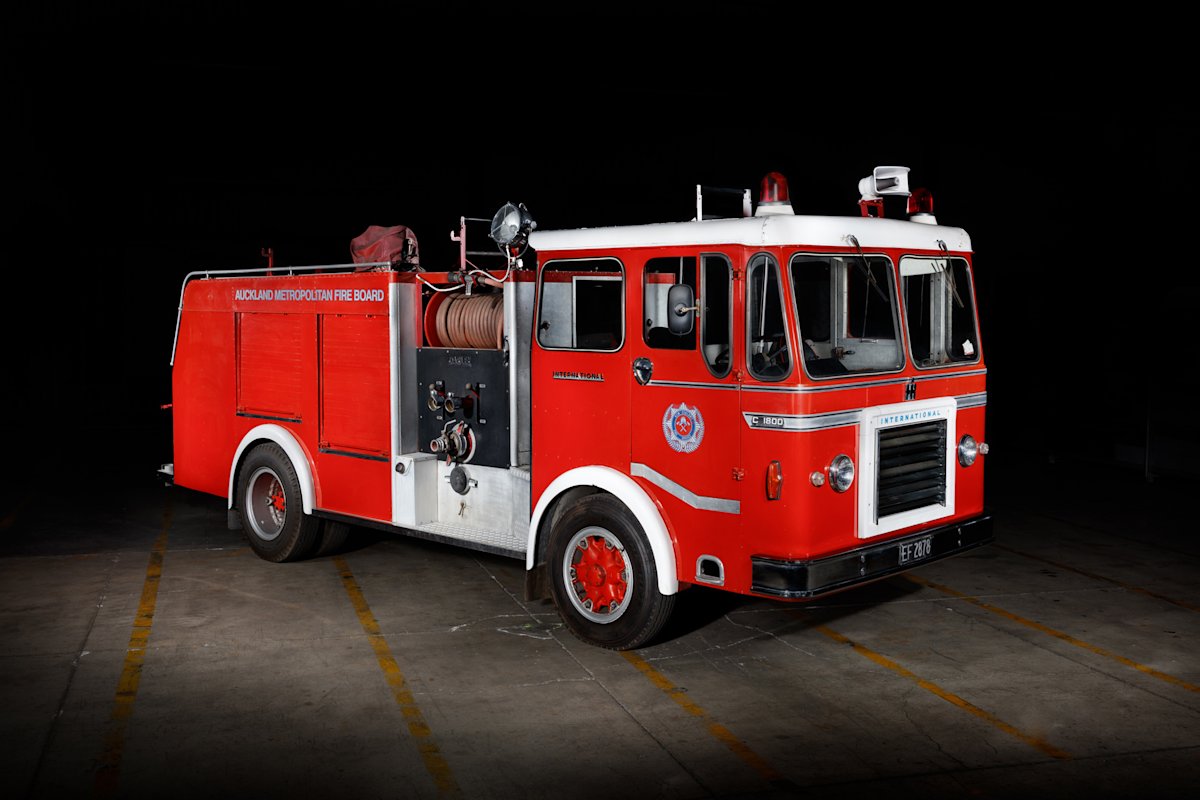
1969 International C1800
This type of squared-off "butterbox" American truck marked a sea change in New Zealand fire appliances, moving from compact English machines to bigger and more powerful appliances which originated in the USA. Dozens of trucks like this ended up all over the country, mostly sourced from International Harvester’s Melbourne truck plant, although often their bodies were built and fitted locally by Mills-Tui in Rotorua (which still does emergency-related work) or by Wormald-Hale in Auckland.
Fitted with a competent Darley three-stage pump for high- and low-pressure water delivery, this truck did over 5 million kilometres in New Zealand fire service. It was also the first NZ firefighting appliance equipped with a high-pressure fog hose and electronic sirens. Of the 50-plus C1800 fire trucks once in New Zealand, it appears only two remain – this example, plus another in a private collection. When the vehicle entered the MOTAT Collection in 1988, it was restored by Mills Tui in time for the First World Firefighter Games in 1990.
Image: Fire Engine, F1156.2003. The Museum of Transport and Technology (MOTAT).
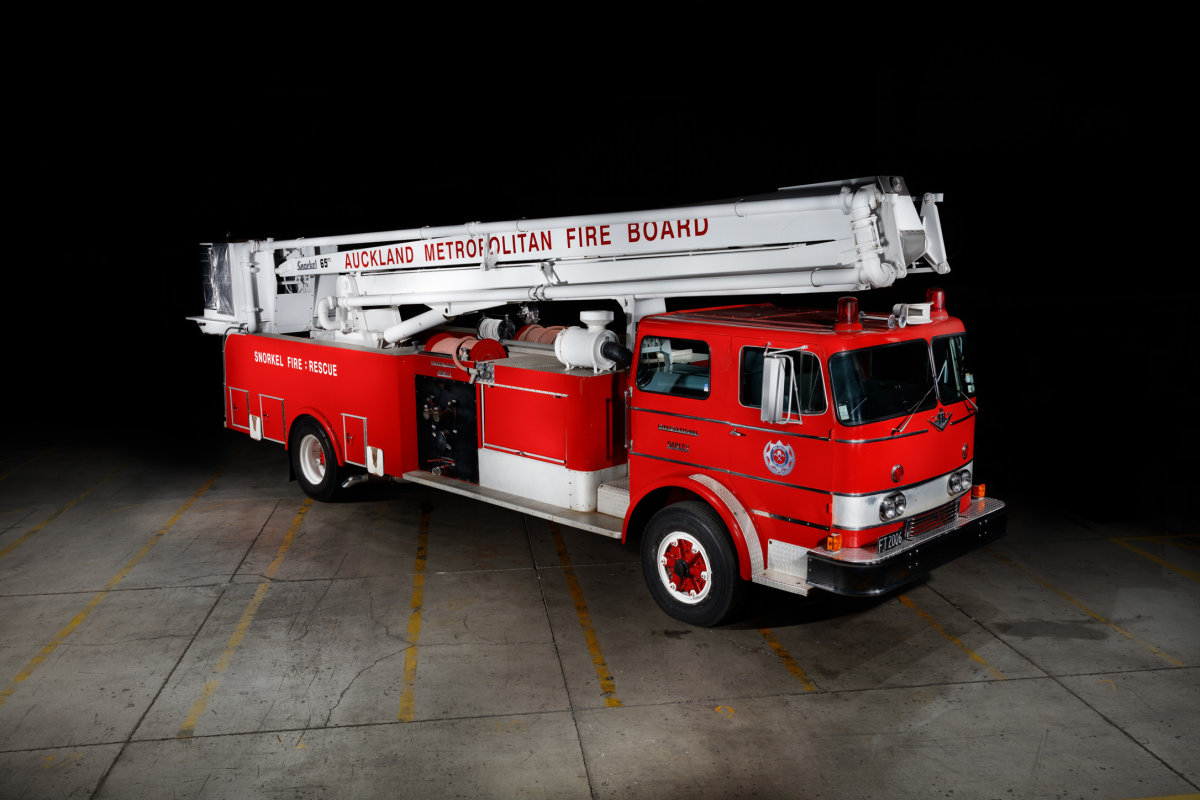
1971 Darley International Snorkel
Tāmaki Makaurau had experienced a spate of serious fires, and the Snorkel was so urgently needed it was first called out in the middle of its commissioning process to attend a fire at the Sheepskin Rug Shop in Penrose on 11th November 1971. Once commissioned, it was stationed at Auckland Central Fire Station from 1971 until 1981. It was then in reserve until 2002 for Auckland Central and Manukau Fire Stations.
The appliance has a Pitman branded Hydraulic Extending Platform (HEP) or “Snorkel” which extends 19.8 metres for either rescue work or to direct streams of water from height. The Snorkel was built onto a specialised International truck firefighting chassis to which Darley fitted the pumping equipment and Wormald’s the Pitman HEP.
The fire engine’s cab was made by the Cincinnati Cab Company, but the rest of the body was added locally in New Zealand by Apex Motor Bodies, Auckland. The appliance was joint venture between International Harvester and Wormald Brothers in Pōneke/Wellington who sourced the Snorkel.
Image: Fire Engine, 2002.18. The Museum of Transport and Technology (MOTAT).
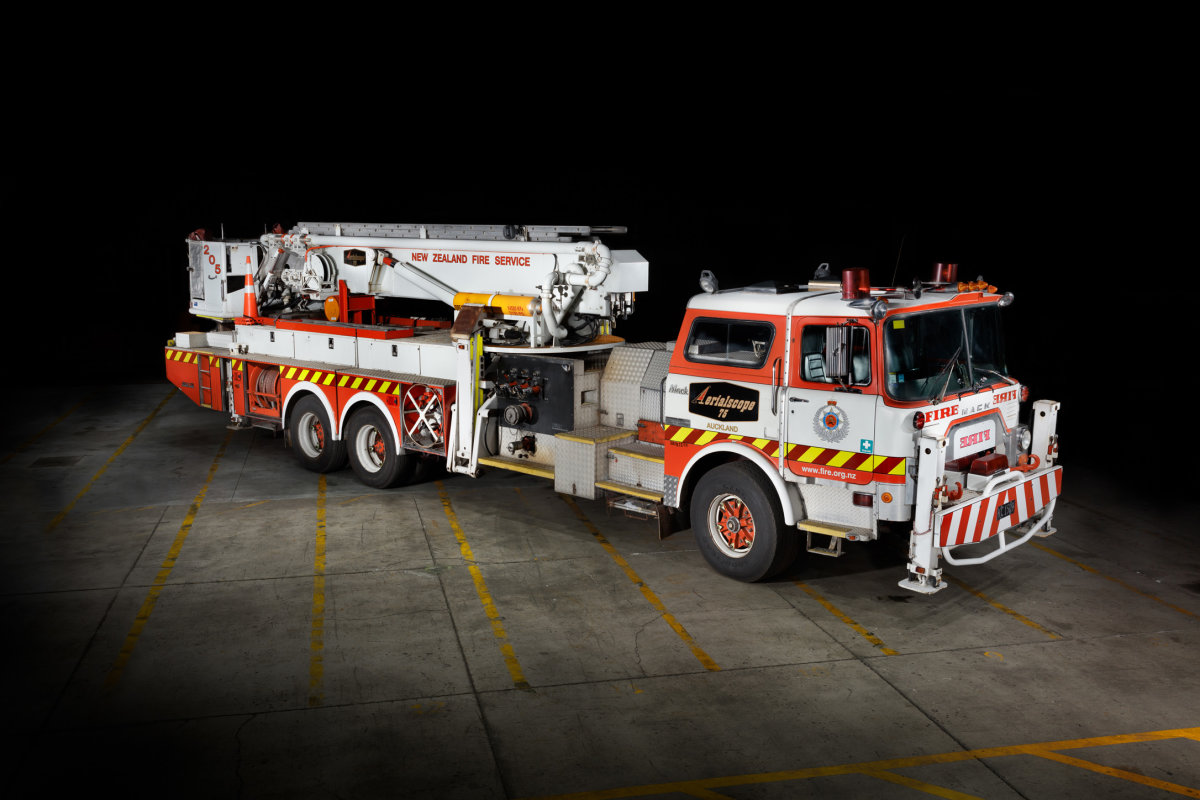
1981 Mack 75 Aerialscope
Comprising a Baker Aerialscope mounted on a Mack CF612 truck chassis, this is the only right-hand-drive Mack Aerialscope assembled in the entire world, the only one fitted with a Darley pump and the only one to serve its working life outside continental North America.
Aerialscopes were first introduced in New York in 1965 where they met with instant success. They easily negotiated the narrow busy streets and could reach multi-storied buildings set back from the road. This one-of-a-kind appliance operated out of the Auckland Central Fire Station from 1981 and attended almost every major fire in the region during its 30-year service.
The Aerialscope telescopic ladder can be operated either from the manned basket, or from the operator’s platform mounted on the vehicle’s deck and can extend to 22.86 metres (75 feet) with its manned basket. In turn this can hold an impressive 450kgs in any position at any angle, even with water flowing.
Image: Fire Engine, 2013.265. The Museum of Transport and Technology (MOTAT).
Words prepared by Mark Webster (Collections Researcher – Fire and Emergency) and Chelsea Renshaw (Transport Curator)
Article published March 2024.